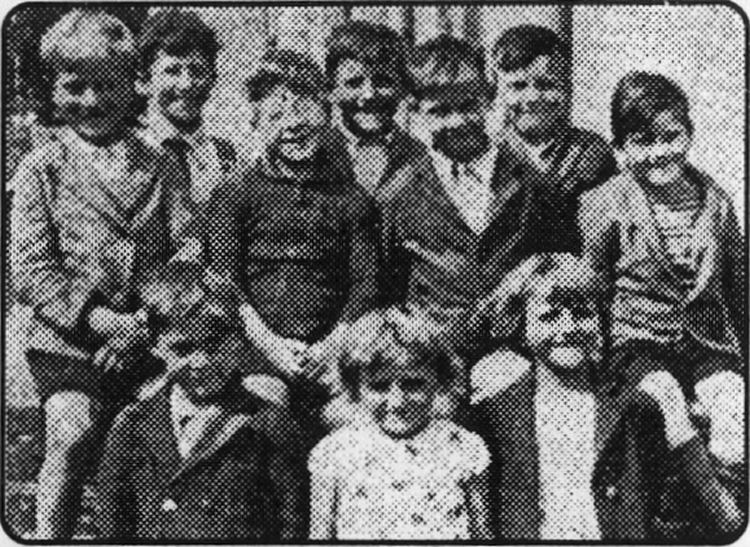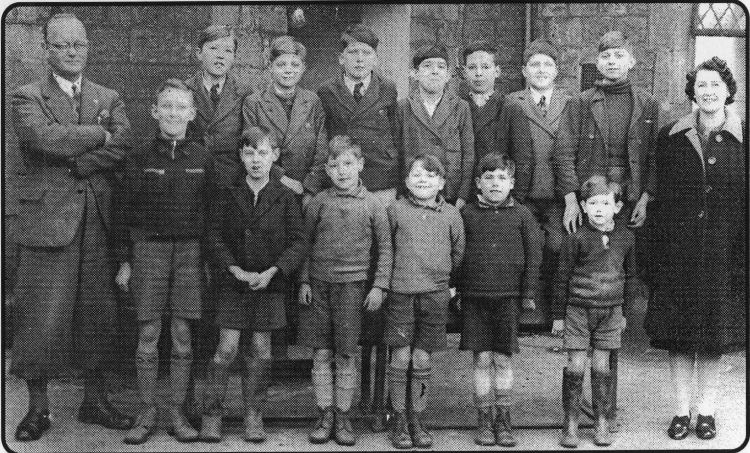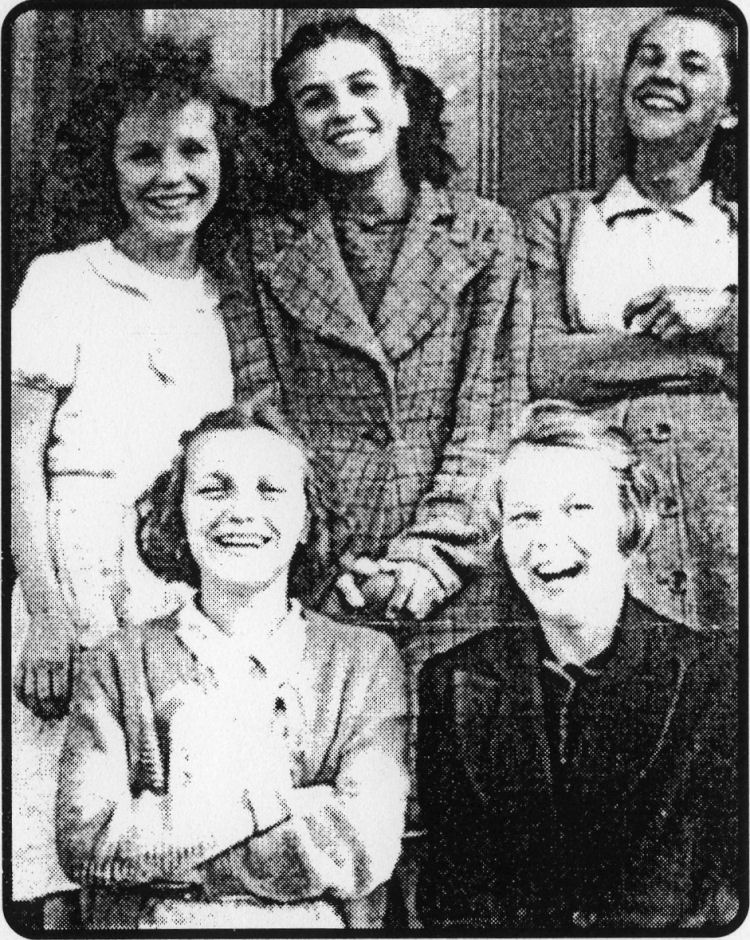
From the Folkestone Herald Published 25 November 1999
Evacuees fun

The Herald picture of Dover Road infants we sent to ‘Old boy’ Robin
Doughty and was featured in Memories on October 14. See story below.
PARTICULARLY interested in the Herald picture used in my Memories column
recently, of a group of Folkestone schoolchildren who were evacuated to
Penault, in Monmouthshire, South Wales, during the Second World War, was a
reader whose father also went to the Dover Road school.
She is Mrs Shirley Macfarlane, of Eastfields, Folkestone, who wrote to tell
me the photograph had jogged a lot of memories for her parents, and that she
had among her family pictures a photograph of the next age group, who went
to Penault.
That morale boosting picture, actually taken in Penault, shows her father,
Jim Bates, on the extreme left in the front row. He was about 11.

EVACUEES: In mid-October we featured Dover Road infants in Raglan,
Monmouthshire. Above we have some of the older boys who went to Penault,
including Jim Bates, of Greatstone. He is extreme left in the front row,
when he was 11.
Mr Bates, 73, who lives in Greatstone, was a painter and decorator and one
of Shirley’s childhood memories is of walking along the Leas with her mother
who pointed out her father, in his white overalls, working at the top of the
Metropole Hotel.
His family used to live in the Harbour area, mainly at Mount Pleasant Road.
And her grandfather, Bill Bates, she said, used to have an allotment near
where her home was built at Eastfields.
It was only when she brought the school group picture to the Herald
offices that Shirley began to realise her father’s old school was at Dover Road, not far from where she works at
the local Health Centre!
Shirley told me her father could not recall names of the other boys in his
class. But pencilled on the back of the picture is the name, Ray Cutter,
although she doesn’t know why.
If any reader wants to contact Shirley about the photograph, her number is
01303 244759.
Surprise
Another evacuees photograph, this time of girls,
was sent to me by Trevor J. Page, of Flaxpond Road, Ashford.

INFORMATION wanted: These evacuees in Cilgerran, in Wales are believed to
come from the Hythe area. Can any reader name them?
This was prompted by a holiday in Wales at the beginning of September when
he visited the Cardigan Heritage Centre.
“Apart from being excellent, showing all aspects of local history,” said
Trevor, “it also has a comprehensive history of World War Two” - which shows
some schools, at least, DO tell our children of today about the War, and I
am pleased about that.
And Trevor Page enclosed a
photocopy of a picture the Heritage Centre sent him, with a caption in Welsh
and English, which reads “Evacuees in Cilgerran during the last war. The
girls are thought to have come from Hythe in Kent."
Trevor told me: “I would be grateful if you could publish the photograph, as
I would be interested to know where the children are now. Any resulting
information will enhance an already fascinating exhibition.
“The photograph actually comes from a book entitled ‘The Teifi Valley in Old
Photographs’ by Alan Sutton Publishing.”
 |
|
1899
Town is urged to support amusements association
GREAT many ladies, we are told, occupied seats in the
body of the Town Hall and Its balconies when Cllr William Charles
Carpenter was voted mayor of Folkestone for the coming year. Whether
this fact had special significance the local press did not say, and a
quote from Cllr Carpenter doesn’t help. One editor, said the new mayor,
had described him as “a little fat round man." He went on to call on the
council to take up Lord Radnor's offer of land opposite Cheriton Road
cemetery for a new cricket ground and for council and town to give more
backing In future to the Amusements Association whose work was so vital
in entertaining visitors and residents. Among those In the public seats
was James Rye who was due shortly to become a centenarian. Glowing
tribute was paid to the retiring mayor Alderman Salter, by fellow
Alderman Pledge who said his only regret was “that her Majesty had not
conferred on him a Knighthood or a baronetcy!” Aid Salter spoke of the
great honour it had been to welcome to Folkestone first, Lord Kitchener,
and then Queen Victoria.” Tests were carried out at Aldershot with 15
traction engines hauling trains of wagons over rough ground prior to
being sent out for use by the Army in South Africa.
|
|
1924
Motor giant celebrates its 10 millionth people’s car
FORD dealers Rowland-Rouse Ltd, of Folkestone and Dover had a
full page advertisement
on the front of the Herald highlighting the industrial achievement of
Ford in turning out the 10 mlllionth car from their Highland Park
factories In June. The advert told of the day In 1893 when the first car
had been completed In a little brick workshop, and the little engine
first ran at 3am on a chilly winter’s day. That was the result of two
years of intense effort and years of study; and that car was still
running in 1924. Hythe Town Council decided to enforce a limit of three
buses at a bus stop at one time and a waiting time of only minutes in an
attempt to regulate public services. One councillor told of once
counting 14 buses waiting at Red Lion Square. There was already a three-minute
limit but it had not been enforced. Herald writer Felix spoke of the
most remarkable change of opinion among many people who now, after 50
years of debate, were at last in agreement that a site at West Cliff
House would be the best place for a long awaited Band Pavilion needed on
or near the Leas. A pasture farm In the Alkham-Hawkinge area occupied by
James Jell was sold at auction by Barton & Harrison to John Marsh for
£510. In the same area a 7.5 acre plot made £380.
|
|
1949
Licensees fear big threat to the tied public houses
A WELL attended meeting at the old Majestic Hotel members of
Folkestone & District Licensed Victuallers group were urged to Work
together more for the common good. The meeting was attended by
representatives from licensed businesses in Dover, Ashford and Wingham.
Chairman Mr Hurson Giffard spoke of a difficult year and was pessimistic
about the future. The trade had been hit by a new Government licensing
Bill and the “Bing Bill” threat to abolish tied public houses. He and
the secretary had been to the House of Commons to press the case for the
pub trade and enlisted the support of MP Brigadier H Mackeson of Hythe.
New president in the coming year was to be Smith's crisps boss Sir
Herbert Morgan. Equality for women was beginning to become an issue and
at a meeting of the local Trades Council Cllr Mrs E Barton asked why no
women were among 10 names put forward as nominees for membership of
Folkestone’s Employment Committee. Judging by the press report of the
meeting there was no direct answer to her question, neither was a
woman’s name among the three names put forward to be JPs, selected from
nine nominations from unions. The Co-op began work on creating a modern
fashion and drapery store in Tontine Street due to open the following
summer.
|
|
1974
How Oliver Cromwell took on the smugglers of Marsh
SHEPWAY Council had a controversial plan to spend £1.6
million on buying 140 privately-owned houses for letting to council
tenants. Other major schemes Included coast defence work costing over
£500,000. Another 1,000 homes were thought to be necessary, costing more
than £15.5milllon. Smuggling memories - Military personnel and civilians
have learned over the years how to live in harmony at Lydd. But It may
not have been quite the same In the old days, years ago when the town’s
people lived In the midst of a thriving hotbed of local smugglers, Miss
Anne Roper told Folkestone Herald readers 25 years ago. She traced the
flourishing Lydd smuggling trade, which continued right up to the
opening of the 20th Century, back to the 14th Century when Edward II
banned all exports of fleeces and set up a wool market in London. There
all fleeces by law had to bought or sold. The men of Lydd resented this
because sheep were their only Industry’ and getting their wool to
market was costly. They had more trade with France and Holland than they
did with the rest of the country. Europeans, taking advantage of shallow
beaches near Lydd would trade wine and brandy for fleeces and probably
sheep too. The hush hush trading flourished until Oliver Cromwell
realised the loss to national revenues and organised a preventive
service to clamp down on smuggling.
|
|




